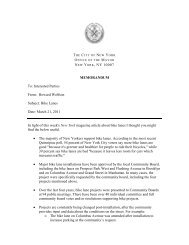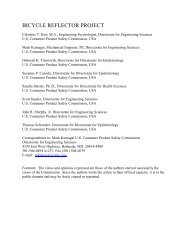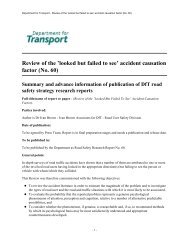Guide for the Development of Bicycle Facilities - The Industrialized ...
Guide for the Development of Bicycle Facilities - The Industrialized ...
Guide for the Development of Bicycle Facilities - The Industrialized ...
Create successful ePaper yourself
Turn your PDF publications into a flip-book with our unique Google optimized e-Paper software.
guide <strong>for</strong> <strong>the</strong> development <strong>of</strong> bicycle facilities 33<br />
Shared Use Paths<br />
Use Paths<br />
Shared use paths are facilities on exclusive right-<strong>of</strong>-way and with minimal<br />
cross flow by motor vehicles. Shared use paths are sometimes<br />
referred to as trails; however, in many states <strong>the</strong> term trail means an unimproved<br />
recreational facility. Care should be taken in using <strong>the</strong>se terms<br />
interchangeably. Where shared use paths are called trails, <strong>the</strong>y should<br />
meet all design criteria <strong>for</strong> shared use paths to be designated as bicycle<br />
facilities. Users are non-motorized and may include but are not limited<br />
to: bicyclists, in-line skaters, roller skaters, wheelchair users (both<br />
non-motorized and motorized) and pedestrians, including walkers, runners,<br />
people with baby strollers, people walking dogs, etc. <strong>The</strong>se<br />
facilities are most commonly designed <strong>for</strong> two-way travel, and <strong>the</strong> guidance<br />
herein assumes a two-way facility is planned unless o<strong>the</strong>rwise<br />
stated.<br />
Shared use paths can serve a variety <strong>of</strong> purposes. <strong>The</strong>y can provide users<br />
with a shortcut through a residential neighborhood (e.g., a connection<br />
between two cul-de-sac streets). Located in a park, <strong>the</strong>y can provide an<br />
enjoyable recreational opportunity. Shared use paths can be located<br />
along rivers, ocean fronts, canals, abandoned or active railroad and utility<br />
rights-<strong>of</strong>-way, limited access freeways, within college campuses or<br />
within and between parks. Shared use paths can also provide bicycle access<br />
to areas that are o<strong>the</strong>rwise served only by limited access highways<br />
closed to bicycles. Appropriate locations can be identified during <strong>the</strong><br />
planning process. Examples <strong>of</strong> shared use paths are shown in Figures 15<br />
and 16.<br />
Shared use paths should be thought <strong>of</strong> as a complementary system <strong>of</strong><br />
<strong>of</strong>f-road transportation routes <strong>for</strong> bicyclists and o<strong>the</strong>rs that serves as a<br />
necessary extension to <strong>the</strong> roadway network. Shared use paths should<br />
not be used to preclude on-road bicycle facilities, but ra<strong>the</strong>r to supplement<br />
a system <strong>of</strong> on-road bike lanes, wide outside lanes, paved<br />
shoulders and bike routes. <strong>The</strong>re are some similarities between <strong>the</strong> design<br />
criteria <strong>for</strong> shared use paths and highways (e.g., horizontal<br />
alignment, sight distance requirements, signing and markings). On <strong>the</strong><br />
o<strong>the</strong>r hand, some criteria (e.g., horizontal and vertical clearance requirements,<br />
grades and pavement structure) are dictated by operating<br />
characteristics <strong>of</strong> bicycles that are substantially different from those <strong>of</strong><br />
motor vehicles. <strong>The</strong> designer should always be aware <strong>of</strong> <strong>the</strong> similarities<br />
and differences between bicycles and motor vehicles and <strong>of</strong> how <strong>the</strong>se<br />
similarities and differences influence <strong>the</strong> design <strong>of</strong> shared use paths. <strong>The</strong><br />
remainder <strong>of</strong> this section provides guidance on each <strong>of</strong> <strong>the</strong> factors that<br />
should be considered in designing safe and functional shared use paths.<br />
Figure 15. Example <strong>of</strong> a Shared Use Path<br />
Figure 16. Example <strong>of</strong> a Shared Use Path<br />
Separation Between Shared Use Paths and Roadways<br />
When two-way shared use paths are located immediately adjacent to a<br />
roadway, some operational problems are likely to occur. In some cases,<br />
paths along highways <strong>for</strong> short sections are permissible, given an appropriate<br />
level <strong>of</strong> separation between facilities, as in Figure 16. Some<br />
Design<br />
Shared Use Paths





